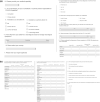The international European Academy of Neurology survey on neurological symptoms in patients with COVID-19 infection
- PMID: 32558002
- PMCID: PMC7323212
- DOI: 10.1111/ene.14407
The international European Academy of Neurology survey on neurological symptoms in patients with COVID-19 infection
Abstract
Background and purpose: Although the main clinical features of COVID-19 infection are pulmonary, several associated neurological signs, symptoms and diseases are emerging. The incidence and characteristics of neurological complications are unclear. For this reason, the European Academy of Neurology (EAN) core COVID-19 Task Force initiated a survey on neurological symptoms observed in patients with COVID-19 infection.
Methods: A 17-question online survey was made available on the EAN website and distributed to EAN members and other worldwide physicians starting on 9 April 2020.
Results: By 27 April 2020, proper data were collected from 2343 responders (out of 4199), of whom 82.0% were neurologists, mostly from Europe. Most responders (74.7%) consulted patients with COVID-19 mainly in emergency rooms and in COVID-19 units. The majority (67.0%) had evaluated fewer than 10 patients with neurological manifestations of COVID-19 (neuro COVID-19). The most frequently reported neurological findings were headache (61.9%), myalgia (50.4%), anosmia (49.2%), ageusia (39.8%), impaired consciousness (29.3%) and psychomotor agitation (26.7%). Encephalopathy and acute cerebrovascular disorders were reported at 21.0%. Neurological manifestations were generally interpreted as being possibly related to COVID-19; they were most commonly recognized in patients with multiple general symptoms and occurred at any time during infection.
Conclusion: Neurologists are currently and actively involved in the management of neurological issues related to the COVID-19 pandemic. This survey justifies setting up a prospective registry to better capture the prevalence of patients with neuro COVID-19, neurological disease characteristics and the contribution of neurological manifestations to outcome.
Keywords: COVID-19; coronavirus; neurological; survey.
© 2020 European Academy of Neurology.
Conflict of interest statement
E. Moro, A. Priori, E. Beghi, R. Helbok, L. Campiglio, C. Bassetti, E. Bianchi, L. Maia, S. Ozturk, F. Cavallieri, M. Zedde, J. Sellner, D. Bereczki, M. Rakusa, G. Di Liberto, A. Sauerbier, A. Pisani, A. Macerollo, R. Soffietti, P. Taba, C. Oreja‐Guevara, B. Bodini, T. Jenkins and TJ von Oertzen have nothing to declare related to this study. M. Crean and A. Twardzik are employed by the EAN.
Figures




References
-
- World Health Organization . Coronavirus disease (COVID‐2019) situation reports. 2020. https://www.who.int/emergencies/diseases/novel‐coronavirus‐2019/situatio... (accessed 17/05/2020).
-
- Watson J, Brush JE. Interpreting a COVID‐19 test result. BMJ 2020; 369. doi: 10.1136/bmj.m1808. - PubMed
MeSH terms
LinkOut - more resources
Full Text Sources
Medical
Miscellaneous

